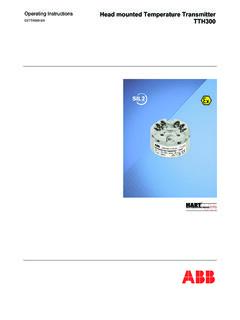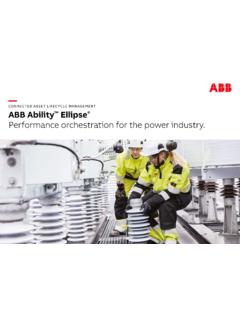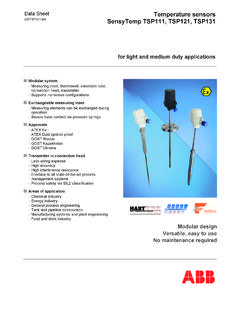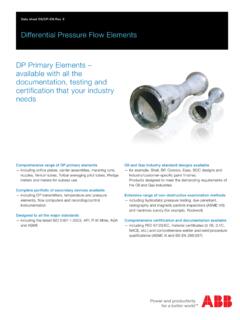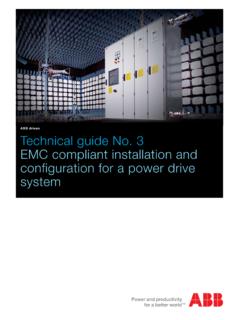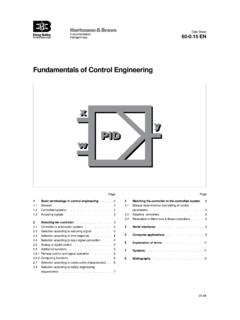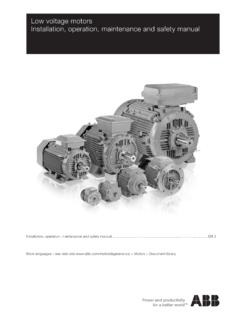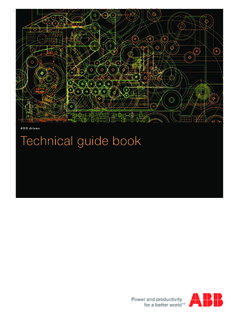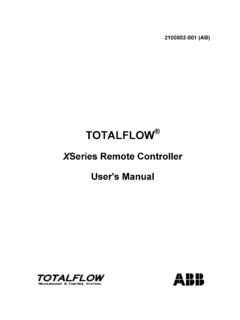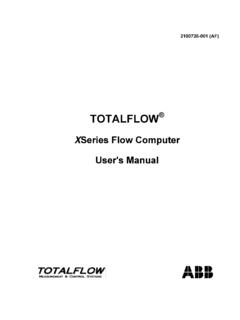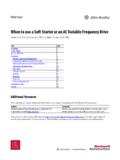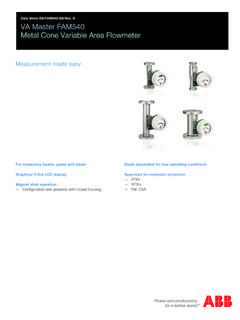Transcription of ABB drives - Technical guide No. 4, Guide to variable ...
1 Technical Guide No. 4 Guide to variable speed drivesABB drives2 Guide to variable speed drives | Technical Guide No. 4 Technical Guide No. 4 | Guide to variable speed drives 3 Copyright 2011 ABB. All rights subject to change without notice. 3 AFE61389211 REV C Guide No. 4 Guide to variable speed drives4 Guide to variable speed drives | Technical Guide No. 4 Technical Guide No. 4 | Guide to variable speed drives 5 ContentsChapter 1 - Introduction ..7 General ..7 Chapter 2 - Processes and their requirements ..8 Why variable speed control? ..8 Industrial segments with VSD in processing systems ..10 Machines are used to alter materials ..11 Well defined shape.
2 11 Indefinite shape .. to transport materials ..12 Solid materials ..12 Liquid materials ..12 Gaseous materials ..12 Chapter 3 - The workhorse of industry: the electric motor ..13 Electric motors drive most machines ..13 Motors convert electrical energy into mechanical energy ..14 Frequency converters control electromagnetic induction ..15 The efficiency of the drive system ..16 Reversed rotation or torque is sometimes required ..17 The load, friction and inertia resist rotation ..18 The motor has to overcome the loading torque ..19 The drive torque and load torque are equal at nominal speed ..20 Chapter 4 - variable volumes require some form of control ..21 variable material flow and input/output requirements.
3 21 Simpler control methods ..22 The best control method is VSD ..23 Mechanical, hydraulic and electrical VSDs ..24 Hydraulic coupling ..24DC drive ..24AC drive ..24 Electrical VSDs dominate the market ..25 Maintenance costs ..25 Productivity ..25 Energy saving ..25 Higher quality ..25 The AC drives market is growing fast ..26 Chapter 5 - AC drive: The leading control method ..27 The basic functions of an AC drive ..27A motor s load capacity curves with an AC drive ..286 Guide to variable speed drives | Technical Guide No. 4AC drive features for better process control ..29 Reversing ..30 Torque control ..30 Eliminating mechanical vibrations ..30 Power loss ride-through.
4 31 Stall function ..31 Slip compensation ..32 Flying start ..32 Environmental features .. 6 - Cost benefits of AC drives ..34 Technical differences between other systems and AC drives ..35No mechanical control parts needed ..36 Factors affecting cost ..37 Investment costs: mechanical and electrical components ..38 The motor ..38 The AC costs: throttling compared to AC drive ..39 Operational costs: maintenance and drive energy ..40 Total cost comparison ..41 Chapter 7 - Index ..42 Technical Guide No. 4 | Guide to variable speed drives 7 Chapter 1 - IntroductionGeneralThis Guide continues ABB s Technical Guide series, describing different variable speed drives (VSD) and how they are used in industrial processes.
5 Special attention has been given to electri-cal VSDs and especially to AC Guide tries to be as practical as possible. No special know-ledge of VSDs is required, although basic Technical know-how is required to fully understand the terms and descriptions Guide to variable speed drives | Technical Guide No. 4 Chapter 2 - Processes and their requirementsWhy variable speed control?To understand why variable speed control is necessary, we first need to understand the requirements of different processes. These processes can be divided into two main categories; material treatment and material transport, although there are many different sub-categories that come under these two basic to both main categories, however, is the need to be able to adjust the process.
6 This is accomplished with VSDs. This chapter describes the main industrial and non-industrial processes using Guide No. 4 | Guide to variable speed drives 9 ExamplesIndustrial:Chemical industryPulp, paper, printingFood & beveragePower plantsMiningMetal industryMachine shopsPlasticsTextilesNon-industrial:HVAC W ater treatmentIndustrial segments with VSD processesIndustrial processes are numerous, and the list above mentions just some of the industrial segments with VSD processes. What they have in common is that they all require some kind of control using VSD. For example, in air conditioning applications (part of HVAC), air flow requirements change according to the humidity and tem-perature in the room.
7 These can be met by adjusting the supply and return air fans. These adjustments are carried out with are also used in power plants and the chemical industry. In both cases, the fans need to be adjusted according to the main process. In power plants, the main process changes due to varying demands for power at different times of the year, day or week. Likewise, the need for VSDs differs according to the and their requirements10 Guide to variable speed drives | Technical Guide No. 4 Processes and their requirementsVariables in processing systemsThis diagram shows what kinds of variables affect the processing system. These variables can be divided into energy and mate-rial variables.
8 In the processing system itself, material or energy is processed by means of mechanical power, electromagnetic influence, thermal influence, chemical and biological reactions or even nuclear power. Each process needs the material and energy supplied to accom-plish the required process. The product or final material state is the output of the process, but in every process, waste, in the form of energy and/or material, is also processing systems, VSDs are used to control the mechanical power of the different machines involved in the treatment can also be controlled by VSDs. A good ex-ample is a drying kiln, in which the hot air temperature must be constant. The process is controlled by controlling the speed of the hot air fans using Guide No.
9 4 | Guide to variable speed drives 11 Processes and their requirements Machines are used to alter materials mentioned earlier in this Guide , working machine processes can be divided into two categories. The first category is material treatment, which is accomplished using various types of process-ing apparatus to alter a material s properties into another form. Well defined shapeProcessing apparatus can be divided into two groups according to the resulting shape of the material being treated. The shape can be either well defined or indefinite. Materials with a well-defined shape, such as paper, metal and wood, are processed with machinery. Examples are paper machines, rolling mills and saw mill lines.
10 Indefinite shapeMaterials with an indefinite shape, such as various food products, plastics etc., are processed with plant equipment. Examples of this kind of equipment are margarine stirrers, and different kinds of centrifuges and Guide to variable speed drives | Technical Guide No. 4 Processes and their to transport materialsThe second category consists of machines which transport material to a desired location. This group consists of conveying, dosing and pressure changing apparatus. These machines can be divided into three different sub-groups according to whether the type of material being treated is a solid, liquid or materialsSolid materials, such as shipping containers, metal, wood, miner-als and of course people, are transported by conveying appara-tus.
